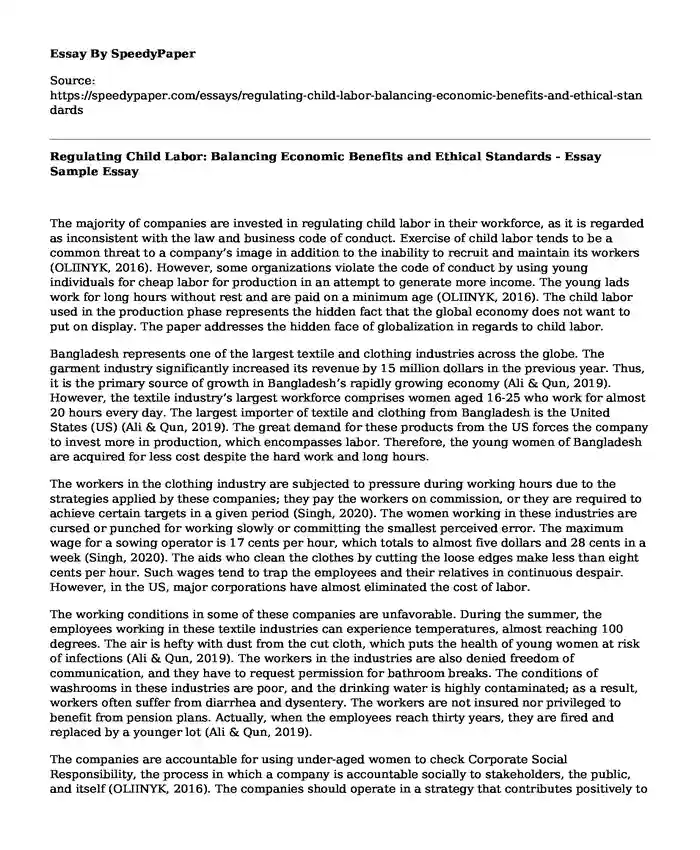
| Type of paper: | Essay |
| Categories: | Company Business Child abuse |
| Pages: | 3 |
| Wordcount: | 697 words |
The majority of companies are invested in regulating child labor in their workforce, as it is regarded as inconsistent with the law and business code of conduct. Exercise of child labor tends to be a common threat to a company’s image in addition to the inability to recruit and maintain its workers (OLIINYK, 2016). However, some organizations violate the code of conduct by using young individuals for cheap labor for production in an attempt to generate more income. The young lads work for long hours without rest and are paid on a minimum age (OLIINYK, 2016). The child labor used in the production phase represents the hidden fact that the global economy does not want to put on display. The paper addresses the hidden face of globalization in regards to child labor.
Bangladesh represents one of the largest textile and clothing industries across the globe. The garment industry significantly increased its revenue by 15 million dollars in the previous year. Thus, it is the primary source of growth in Bangladesh’s rapidly growing economy (Ali & Qun, 2019). However, the textile industry’s largest workforce comprises women aged 16-25 who work for almost 20 hours every day. The largest importer of textile and clothing from Bangladesh is the United States (US) (Ali & Qun, 2019). The great demand for these products from the US forces the company to invest more in production, which encompasses labor. Therefore, the young women of Bangladesh are acquired for less cost despite the hard work and long hours.
The workers in the clothing industry are subjected to pressure during working hours due to the strategies applied by these companies; they pay the workers on commission, or they are required to achieve certain targets in a given period (Singh, 2020). The women working in these industries are cursed or punched for working slowly or committing the smallest perceived error. The maximum wage for a sowing operator is 17 cents per hour, which totals to almost five dollars and 28 cents in a week (Singh, 2020). The aids who clean the clothes by cutting the loose edges make less than eight cents per hour. Such wages tend to trap the employees and their relatives in continuous despair. However, in the US, major corporations have almost eliminated the cost of labor.
The working conditions in some of these companies are unfavorable. During the summer, the employees working in these textile industries can experience temperatures, almost reaching 100 degrees. The air is hefty with dust from the cut cloth, which puts the health of young women at risk of infections (Ali & Qun, 2019). The workers in the industries are also denied freedom of communication, and they have to request permission for bathroom breaks. The conditions of washrooms in these industries are poor, and the drinking water is highly contaminated; as a result, workers often suffer from diarrhea and dysentery. The workers are not insured nor privileged to benefit from pension plans. Actually, when the employees reach thirty years, they are fired and replaced by a younger lot (Ali & Qun, 2019).
The companies are accountable for using under-aged women to check Corporate Social Responsibility, the process in which a company is accountable socially to stakeholders, the public, and itself (OLIINYK, 2016). The companies should operate in a strategy that contributes positively to society. Bangladesh is using cheap labor from young women to reduce the cost of production. Nevertheless, the industries are the largest exporters of textile and clothing in the world (OLIINYK, 2016). The great impact these companies have on the global economy can overlook the unethical production scheme in the local market. It is essential that these companies adopt better policies to enable them to reach their full potential and impact society positively.
References
Ali, M., & Qun, W. (2019). Revealed Comparative Advantage of Textile and Clothing Industry of Bangladesh in the North American Market. Journal Of Business Management And Economic Research, 3(1), 28-42. https://doi.org/10.29226/tr1001.2019.100
OLIINYK, O. (2016). Implementation of the Corporate Social Responsibility in Labour Relations. Demography And Social Economy, (1), 31-41. https://doi.org/10.15407/dse2016.01.031
Singh, G. (2020). The Indian Textile Industry in Post Quota Era with Reference to Bangladesh. International Journal Of Psychosocial Rehabilitation, 24(5), 2612-2623. https://doi.org/10.37200/ijpr/v24i5/pr201962
Cite this page
Regulating Child Labor: Balancing Economic Benefits and Ethical Standards - Essay Sample. (2023, Nov 30). Retrieved from https://speedypaper.com/essays/regulating-child-labor-balancing-economic-benefits-and-ethical-standards
Request Removal
If you are the original author of this essay and no longer wish to have it published on the SpeedyPaper website, please click below to request its removal:
- Report Planning for Walmart Company, Free Paper Sample for Students
- Paper Sample on Sexual Harassment: Violence Against Women Working in Silicon Valley
- Free Essay Sample - Drug and Substance Use As a Teenager
- Managing Customer Experience and Relationships. Essay Example
- Free Essay Example. Digital Content Management Strategy
- Regulating Facebook Dominance. Paper Example
- Free Essay. Make a Self-Assessment
Popular categories




